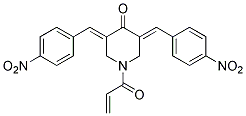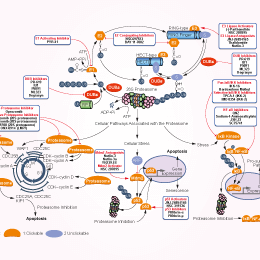
- Bioactive Compounds
- By Signaling Pathways
- PI3K/Akt/mTOR
- Epigenetics
- Methylation
- Immunology & Inflammation
- Protein Tyrosine Kinase
- Angiogenesis
- Apoptosis
- Autophagy
- ER stress & UPR
- JAK/STAT
- MAPK
- Cytoskeletal Signaling
- Cell Cycle
- TGF-beta/Smad
- DNA Damage/DNA Repair
- Compound Libraries
- Popular Compound Libraries
- Customize Library
- Clinical and FDA-approved Related
- Bioactive Compound Libraries
- Inhibitor Related
- Natural Product Related
- Metabolism Related
- Cell Death Related
- By Signaling Pathway
- By Disease
- Anti-infection and Antiviral Related
- Neuronal and Immunology Related
- Fragment and Covalent Related
- FDA-approved Drug Library
- FDA-approved & Passed Phase I Drug Library
- Preclinical/Clinical Compound Library
- Bioactive Compound Library-I
- Bioactive Compound Library-Ⅱ
- Kinase Inhibitor Library
- Express-Pick Library
- Natural Product Library
- Human Endogenous Metabolite Compound Library
- Alkaloid Compound LibraryNew
- Angiogenesis Related compound Library
- Anti-Aging Compound Library
- Anti-alzheimer Disease Compound Library
- Antibiotics compound Library
- Anti-cancer Compound Library
- Anti-cancer Compound Library-Ⅱ
- Anti-cancer Metabolism Compound Library
- Anti-Cardiovascular Disease Compound Library
- Anti-diabetic Compound Library
- Anti-infection Compound Library
- Antioxidant Compound Library
- Anti-parasitic Compound Library
- Antiviral Compound Library
- Apoptosis Compound Library
- Autophagy Compound Library
- Calcium Channel Blocker LibraryNew
- Cambridge Cancer Compound Library
- Carbohydrate Metabolism Compound LibraryNew
- Cell Cycle compound library
- CNS-Penetrant Compound Library
- Covalent Inhibitor Library
- Cytokine Inhibitor LibraryNew
- Cytoskeletal Signaling Pathway Compound Library
- DNA Damage/DNA Repair compound Library
- Drug-like Compound Library
- Endoplasmic Reticulum Stress Compound Library
- Epigenetics Compound Library
- Exosome Secretion Related Compound LibraryNew
- FDA-approved Anticancer Drug LibraryNew
- Ferroptosis Compound Library
- Flavonoid Compound Library
- Fragment Library
- Glutamine Metabolism Compound Library
- Glycolysis Compound Library
- GPCR Compound Library
- Gut Microbial Metabolite Library
- HIF-1 Signaling Pathway Compound Library
- Highly Selective Inhibitor Library
- Histone modification compound library
- HTS Library for Drug Discovery
- Human Hormone Related Compound LibraryNew
- Human Transcription Factor Compound LibraryNew
- Immunology/Inflammation Compound Library
- Inhibitor Library
- Ion Channel Ligand Library
- JAK/STAT compound library
- Lipid Metabolism Compound LibraryNew
- Macrocyclic Compound Library
- MAPK Inhibitor Library
- Medicine Food Homology Compound Library
- Metabolism Compound Library
- Methylation Compound Library
- Mouse Metabolite Compound LibraryNew
- Natural Organic Compound Library
- Neuronal Signaling Compound Library
- NF-κB Signaling Compound Library
- Nucleoside Analogue Library
- Obesity Compound Library
- Oxidative Stress Compound LibraryNew
- Plant Extract Library
- Phenotypic Screening Library
- PI3K/Akt Inhibitor Library
- Protease Inhibitor Library
- Protein-protein Interaction Inhibitor Library
- Pyroptosis Compound Library
- Small Molecule Immuno-Oncology Compound Library
- Mitochondria-Targeted Compound LibraryNew
- Stem Cell Differentiation Compound LibraryNew
- Stem Cell Signaling Compound Library
- Natural Phenol Compound LibraryNew
- Natural Terpenoid Compound LibraryNew
- TGF-beta/Smad compound library
- Traditional Chinese Medicine Library
- Tyrosine Kinase Inhibitor Library
- Ubiquitination Compound Library
-
Cherry Picking
You can personalize your library with chemicals from within Selleck's inventory. Build the right library for your research endeavors by choosing from compounds in all of our available libraries.
Please contact us at info@selleckchem.com to customize your library.
You could select:
- Antibodies
- Bioreagents
- qPCR
- 2x SYBR Green qPCR Master Mix
- 2x SYBR Green qPCR Master Mix(Low ROX)
- 2x SYBR Green qPCR Master Mix(High ROX)
- Protein Assay
- Protein A/G Magnetic Beads for IP
- Anti-Flag magnetic beads
- Anti-Flag Affinity Gel
- Anti-Myc magnetic beads
- Anti-HA magnetic beads
- Poly DYKDDDDK Tag Peptide lyophilized powder
- Protease Inhibitor Cocktail
- Protease Inhibitor Cocktail (EDTA-Free, 100X in DMSO)
- Phosphatase Inhibitor Cocktail (2 Tubes, 100X)
- Cell Biology
- Cell Counting Kit-8 (CCK-8)
- Animal Experiment
- Mouse Direct PCR Kit (For Genotyping)
- New Products
- Contact Us
b-AP15
DUB inhibitor
Synonyms: NSC687852
For research use only.
b-AP15 (NSC687852) is a deubiquitinases inhibitor for 19S proteasomes activity of Ub-AMC cleavage with IC50 of 2.1 μM.

b-AP15 Chemical Structure
Molecular Weight: 419.39
CAS No. 1009817-63-3
Purity & Quality Control
Batch:
Purity:
99.01%
99.01
b-AP15 Related Products
| Related Targets | USP/UBP UCH | Click to Expand |
|---|---|---|
| Related Products | PR-619 P5091 P22077 IU1 ML323 LDN-57444 VLX1570 EOAI3402143 PLpro inhibitor USP25/28 inhibitor AZ1 TCID ML364 SJB2-043 GSK2643943A | Click to Expand |
| Related Compound Libraries | Kinase Inhibitor Library FDA-approved Drug Library Natural Product Library Bioactive Compound Library-I Highly Selective Inhibitor Library | Click to Expand |
Signaling Pathway
Cell Culture and Working Concentration
| Cell Lines | Assay Type | Concentration | Incubation Time | Formulation | Activity Description | PMID |
|---|---|---|---|---|---|---|
| P388 cells | Cytotoxicity assay | Cytotoxicity against murine P388 cells, IC50=0.05 μM | ||||
| human HSC2 | Cytotoxicity assay | Cytotoxicity against human HSC2 by MTT method, CC50=0.094 μM | ||||
| HL60 cells | Cytotoxicity assay | Cytotoxicity against human HL60 cells in presence of RPMI1640 containing 10% fetal bovine serum by trypan blue exclusion test, CC50=0.13 μM | ||||
| Molt 4/C8 cells | Cytotoxicity assay | Cytotoxicity against human Molt 4/C8 cells, IC50=0.15 μM | ||||
| CEM cells | Cytotoxicity assay | Cytotoxicity against human CEM cells, IC50=0.26 μM | ||||
| L1210 cells | Cytotoxicity assay | Cytotoxicity against murine L1210 cells, IC50=0.42 μM | ||||
| HSC4 cells | Cytotoxicity assay | Cytotoxicity against human HSC4 cells by MTT method, CC50=0.56 μM | ||||
| Click to View More Cell Line Experimental Data | ||||||
Mechanism of Action
| Description | b-AP15 (NSC687852) is a deubiquitinases inhibitor for 19S proteasomes activity of Ub-AMC cleavage with IC50 of 2.1 μM. | ||||
|---|---|---|---|---|---|
| Features | Not a general deubiquitinase inhibitor. Has minimal inhibition on recombinant and cytosolic nonproteasomal cysteine deubiquitinases. | ||||
| Targets |
|
In vitro |
||||
| In vitro | b-AP15 inhibits the activity of two 19S regulatory-particle-associated deubiquitinases, ubiquitin C-terminal hydrolase 5 (UCHL5) and ubiquitin-specific peptidase 14 (USP14), resulting in accumulation of polyubiquitin. b-AP15 results in a dose-dependent accumulation of the UbG76V-YFP reporter with IC50 of 0.8 μM, indicating impaired proteasome degradation. b-AP15 (1 μM) results in rapid accumulation of polyubiquitinated proteins in human colon carcinoma HCT-116 cells. b-AP15 (2.2 μM) increases the amounts of the cyclin-dependent kinases CDKN1A and CDKNIB and the tumor suppressor TP53 in a dose-dependent manner without altering the amounts of ornithine decarboxylase 1 (ODC1) in HCT-116 cells. b-AP15 (1 μM) results in G2/M phase cell-cycle arrest in HCT-116 cells, consistent with the accumulation of cell-cycle inhibitors. b-AP15 treatment increases the number of hypodiploid cells and is associated with increased amounts of apoptotic markers, including activated caspase-3, caspase-cleaved poly-ADP ribose polymerase (PARP) and cytokeratin-18 (CK18). b-AP15 is more toxic to HCT-116 cells as compared to immortalized epithelial cells (hTERT-RPE1) or peripheral blood mononuclear cells. b-AP15 inhibits deubiquitinating activity using a variety of substrates, including Ub-AMC, Ub-GFP22, ubiquitinated p53-binding protein homolog (HDM2), and K48- and K63-linked ubiquitin tetramer chains. [1] b-AP15 is an inhibitor of the UPS that induced cell death via induction of the lysosomal apoptosis pathway in a cathepsin-D dependent manner. b-AP15 elicits characteristic UPS defects including the accumulation of ubiquitin conjugates and cell cycle inhibitors such as p21, p27 and the tumor suppressor p53. b-AP15 inhibits the deubiquitinase activity of both cysteine DUBs, with USP14 being slightly more sensitive than UCHL5. b-AP15 induces apoptosis in cells over-expressing the anti-apoptotic Bcl-2 protein and in cells lacking the p53 gene. [2] b-AP15 (1 μM) inhibits ATP-induced IL-1β release from LPS-primed peritoneal macrophages. b-AP15 (1 μM) reduces the levels of cell death induced by nigericin treatment in THP-1 cells. b-AP15 (1 μM) significantly reduces the numbers of ASC specks formed after nigericin treatment in LPS-primed THP-1 cells. [3] | |||
|---|---|---|---|---|
In Vivo |
||
| In vivo | b-AP15 (5 mg/kg) shows significant antitumor activity in severe combined immunodeficiency (SCID) mice with FaDu squamous carcinoma xenografts. b-AP15 (5 mg/kg) significantly delays tumor onset in mice with HCT-116 colon carcinoma xenografts. [1] | |
|---|---|---|
| Animal Research | Animal Models | mice with HCT-116 colon carcinoma xenografts |
| Dosages | 5 mg/kg | |
| Administration | intraperitoneal injection | |
|
Chemical Information
| Molecular Weight | 419.39 | Formula | C22H17N3O6 |
| CAS No. | 1009817-63-3 | SDF | Download b-AP15 SDF |
| Smiles | C=CC(=O)N1CC(=CC2=CC=C(C=C2)[N+](=O)[O-])C(=O)C(=CC3=CC=C(C=C3)[N+](=O)[O-])C1 | ||
Storage and Stability
| Storage (From the date of receipt) | |||
|
In vitro |
DMSO : 48 mg/mL ( (114.45 mM) Moisture-absorbing DMSO reduces solubility. Please use fresh DMSO.) Water : Insoluble Ethanol : Insoluble |
Molecular Weight Calculator |
|
In vivo Add solvents to the product individually and in order. |
In vivo Formulation Calculator |
|||||
Preparing Stock Solutions
Molarity Calculator
In vivo Formulation Calculator (Clear solution)
Step 1: Enter information below (Recommended: An additional animal making an allowance for loss during the experiment)
mg/kg
g
μL
Step 2: Enter the in vivo formulation (This is only the calculator, not formulation. Please contact us first if there is no in vivo formulation at the solubility Section.)
% DMSO
%
% Tween 80
% ddH2O
%DMSO
%
Calculation results:
Working concentration: mg/ml;
Method for preparing DMSO master liquid: mg drug pre-dissolved in μL DMSO ( Master liquid concentration mg/mL, Please contact us first if the concentration exceeds the DMSO solubility of the batch of drug. )
Method for preparing in vivo formulation: Take μL DMSO master liquid, next addμL PEG300, mix and clarify, next addμL Tween 80, mix and clarify, next add μL ddH2O, mix and clarify.
Method for preparing in vivo formulation: Take μL DMSO master liquid, next add μL Corn oil, mix and clarify.
Note: 1. Please make sure the liquid is clear before adding the next solvent.
2. Be sure to add the solvent(s) in order. You must ensure that the solution obtained, in the previous addition, is a clear solution before proceeding to add the next solvent. Physical methods such
as vortex, ultrasound or hot water bath can be used to aid dissolving.
Tech Support
Answers to questions you may have can be found in the inhibitor handling instructions. Topics include how to prepare stock solutions, how to store inhibitors, and issues that need special attention for cell-based assays and animal experiments.
Tel: +1-832-582-8158 Ext:3
If you have any other enquiries, please leave a message.
* Indicates a Required Field






































